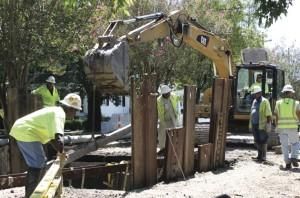No headline provided

September 16, 2011
A section of pavement collapsed on Broadway Street Sept. 3,leaving a large, deep sinkhole between Maple and Hampson streets.The sinkhole was filled, and Broadway Street reopened Tuesdaymorning.
The collapse occurred when a sewer main failure disruptedsediment below the street.
Workers diverted traffic to the south side of the median andestablished a construction zone. The sinkhole was about eight feetdeep, said Robert Jackson, director of community andintergovernmental relations for the Sewerage and Water Board of NewOrleans.
“The sinkhole was larger than it appeared from the surface,”Jackson said. “This was due to concrete overhangs, which wereremoved from the surface to assess the damage and repair thestreet.”
Several students saw the section of Broadway Streetcollapse.
“It was really rainy when it happened,” said junior AaronStusser, who lives on Broadway Street in the Zeta Psi fraternityhouse. “Earlier, I had been outside, and I heard cars scraping theconcrete. Then it collapsed. We watched piece after piece fall in.A BMW almost fell in.”
Stusser and his friends blocked off the street and called theTulane University Police Department.
“An F-250 drove over a spot where there was no sediment underthe road,” said junior Patrick Germain, who was with Stusser whenthe incident occurred. “Our cars were blocked in for a while. Theconstruction literally shook my room every morning.”
Original projections for completion ranged between Sept. 9 andSept. 11. Despite the delay in opening the street, constructioncrews met their goal, Jackson said.
The Sewerage and Water Board of New Orleans had braced forTropical Storm Lee with personnel, pumps and generators, accordingto a Sept. 2 press release.
“Depending on the rainfall for the next few days, there may betimes when heavy rainfall could result in water pooling in thestreets,” Executive Director Marcia St. Martin said in the pressrelease.
The storm may have exacerbated the sewer main failure, Jacksonsaid.
According to the U.S. Geological Survey, a sinkhole occurs whenland loses support from the sediment below the surface. The surfacewill often visually seem intact even when the ground below iseroding, leading to an abrupt and unexpected collapse.
While sinkholes as significant as the one on Maple Street arerare in residential areas, a Local Hazard Mitigation Plan from theSewerage and Water Board of New Orleans addressed the largerproblem of subsidence, or sinking land. The board released a draftof the plan last year.
“Subsidence occurs slowly and continuously over time or onabrupt occasions, as in the case of sudden formation of sinkholes,”according to the plan. “The exact place and time of a disasterrelated to subsidence cannot usually be predicted with any degreeof certainty.”
Jackson said drivers should not be worried about the status ofNew Orleans roads.
“This year, we’ve made about 1,500 water-pipe repairs and 500sewer-pipe repairs,” he said. “These repairs maintain the NewOrleans pipe system and prevent sinkholes.”
Despite witnessing the collapse of their street, Stusser andGermian were unfazed.
“I feel about as safe pulling out of my driveway as anywhereelse in New Orleans,” Germain said.








Leave a Comment